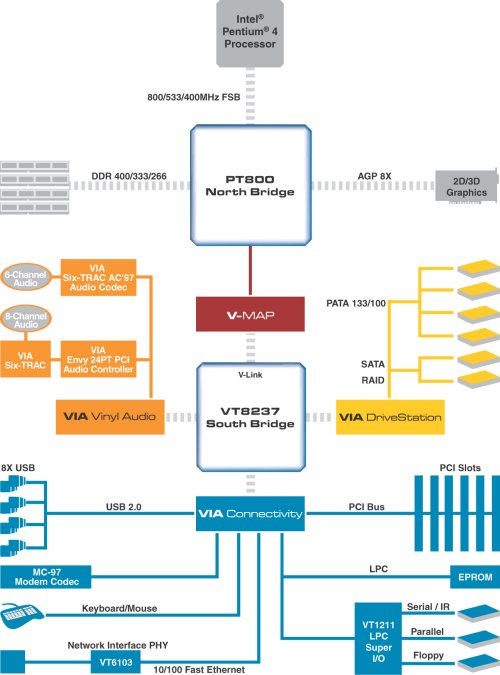PT800 stripped down
There had been rumours that VIA would take this opportunity to launch a dual-channel chipset to compete directly with Intel's finest. That, however, isn't the case with the PT800. VIA is still adamant that a single-channel solution provides the most preferable cost vs. performance trade-off, so we don't expect to see a dual-channel VIA-branded chipset in the very near future. There are performance implications for not fully satiating the P4's bandwidth desire. We'll discuss those below. We'll then run through our benchmarks to discern just where the PT800 stands in relation to the competition.
The simplest and most straightforward manner in dissecting and understanding a new chipset is to have a look at its block diagram. So here we go.

An all-new North Bridge coupled on to a new South Bridge that truly debuted on the AMD KT600 chipset. We'll go from top to bottom with a view of understanding how the PT800 is going to compete with rivals' chipsets..
800FSB support - The 3.0GHz P4 saw the birth of the 800 FSB (200FSB quad-pumped) CPUs. Opening up the FSB and allowing more data to flow through than previous P4s helps in boosting overall performance. The PT800, by its very name, indicates full 800 FSB CPU support. Previous 533/400 FSB CPUs are also catered for, too.
Single-channel memory support - We've previously made mention that the quad-pumped P4 just loves bandwidth. Single-channel chipsets, theoretically speaking, have only been able to meet half the P4's bandwidth requirement. That's precisely why Intel's newest breed feature dual-channel running, giving a potential 6.4GB/s of buffered bandwidth at 200FSB. VIA sticks with a single-channel memory design that's heavily tweaked towards extracting maximum performance via, wait for it, FastStream64 technology. We've seen this technology on, amongst other chipsets, the EPIA M10000, KT400A and KT600. The design is reckoned to use a greater number of prefetch buffers which in turn help to reduce the latency in the memory controller. A controller is most inefficient when it's having to wait for data, so FastStream64, if it works as advertised, should help reduce the idle time of said controller. The question is whether this super-slick controller can overcome the obvious limitations of single-channel memory on a P4 CPU.
VT8237 South Bridge - Updating South Bridges is common fare, as new technologies are often integrated into newer chipset designs. The KT600's S.B was joined to its Northern counterpart with VIA's standard V-Link interconnect, running at 533MB/s. That's not enough for the PT800, it seems, as it sports the new Ultra V-Link, running at a blistering 1GB/s. Expect to see this link as the conduit between other new VIA-based platforms. The PT880, PT890 and CM400 spring to mind. The '8237's storage potential comes under the banner of DriveStation.
Drivestation features native Serial ATA implementation through a 150MB/s dual channel SATA interface (2 SATA drives capable of RAID0 and RAID1) which runs on-chip via the aforementioned 1GB/s Ultra V-Link interconnect. No PCI bus hogging here, folks. VIA further adds to its SATA appeal by a SATALite interface that allows the adding of two further SATA drives from an external PHY (Silicon Image physical layer), thereby affording 4 SATA drives in total. One must bear in mind that the PHY will take the place of the secondary PATA channel. The 4 possible drives gives rise to a number of weird and wonderful RAID formations that fall under the banner of V-RAID, such as RAID0 (striping), RAID1 (mirroring), RAID0+1 (striping and mirroring, 2 drives on each), and JBOD (Just a Bunch Of Disks).
Let's also not forget the 2 standard ATA133-capable PATA channels, which all means that one can connect no less than 6 drives (4 SATA + 2 PATA or 4 PATA + 2 SATA, depending on whether the SATALink is used ) to the VT8237 South Bridge. The 1GB/s interconnect now seems barely adequate to service storage needs, let alone other high-speed devices'.
The '8237's VIA Connectivity features support for 8 USB 2.0 ports but there's no provision for the other high-speed format we love, FireWire. Audio is becoming increasingly important on the very latest motherboards, so VIA offers manufacturers a couple of options. There's integrated 6-channel sound from the Six-TRAC CODEC that boasts 20-bit resolution, a 90dB Signal-to-noise ratio and a spiffy Stylus driver that incorporates Sensaura technology, or one could opt for the Vinyl Audio Gold onboard 7.1-channel surround sound solution powered by the impressive Envy24PT chip, which carries 8-channel support, 24-bit resolution and sampling rates as high as 96KHz. Yum. Of course, manufacturers are free to choose whichever sound subsystem they wish.
In brief summary, then, a revised 800FSB-compliant North Bridge that contains a highly efficient single-channel memory controller, 8x AGP support and provision for up to 4GB of system memory. The accompanying South Bridge, the VT8237, is joined by a 1GB/s Ultra V-Link interconnect. The S.B places great emphasis on native SATA by providing up to 4-disk SATA support. V-RAID then offers excellent RAID flexibility to the SATA package, all through an easy-to-manage OS GUI. Lots of USB 2.0 and provision of decent onboard audio round off the chipset package. FireWire supports is conspicuous by its absence, though.









